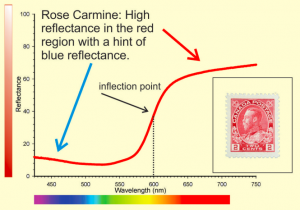One collector, researcher and exhibitor of Canada’s Admiral issue is breaking new ground in his area of specialization by looking at it in a new light.
A chemist with extensive experience in molecular electronic spectroscopy, Richard Judge has an avid interest in the colour of stamps. In his award-winning single-frame exhibit, “The Chemistry of the War Time Admiral,” which is now available in full on the British North America Philatelic Society (BNAPS) website, Judge identified a First World War-era shade solely defined by its spectroscopy.
Last shown at BNAPEX 2018, the exhibit earned a vermeil as well as the Ed and Mickey Richardson Award for its originality, innovativeness, research and high standard of presentation.
“I spent quite a bit of time looking at it rather closely, and it was very nice and very impressive,” said noted Admiral collector Leopold Beaudet, who’s also the editor of The Admiral’s Log newsletter published by BNAPS’ Admiral Study Group.

In an effort to clarify the stamp’s shades, Judge studied its ink chemistry using reflectance (shown above), X-ray fluorescence and Fourier-transform infrared spectroscopy to pinpoint any changes throughout its production history.
“It’s well worth viewing.”
By studying and measuring the spectra produced when matter – such as a stamp – interacts with or emits electromagnetic radiation, Judge showed the shades of the 1911 two-cent carmine Admiral (Scott #106) can be divided into two major groupings. The dating of this transition is shown using plate blocks from across the series.
He also identified an “aniline ink” variety, which he calls “a unique shade for this issue.”
“The term aniline pink is suggested for this grouping as most stamps show significant bleed through,” he wrote in his exhibit.
LONG-RUNNING SERIES
The regular issue of Admiral sheet stamps were produced beginning in late 1911 until late 1927. They were printed by the American Bank Note Company (ABNC) at its Ottawa facility, which became a subsidiary known as the Canadian Bank Note Company in 1923. Early printings were on wet paper, but dry printing began in December 1922.
Across the series, the number of shades peaks at eight with the two-cent carmine; these include carmine, rose carmine, deep rose red, dark carmine, rose red, deep red, red and pink, the latter of which commands a five-times premium.
‘ANILINE VARIETY’
Because the two-cent carmine’s production occurred before, during and after the First World War, there’s inconsistent naming with the stamp’s various shades, including the “well-known but not catalogued” aniline variety.
In an effort to clarify the stamp’s shades, Judge studied its ink chemistry using reflectance, X-ray fluorescence (XRF) and Fourier-transform infrared spectroscopy (FTIR) to pinpoint any changes throughout its production history.
“I think that the inconsistency of naming is primarily a function of time, researchers and the various catalogues that have been in use since the stamp’s production,” said Judge.
In an effort to clarify the stamp’s shades, he studied its ink chemistry using reflectance, X-ray fluorescence (XRF) and Fourier-transform infrared spectroscopy (FTIR) to pinpoint any changes throughout its production history.

